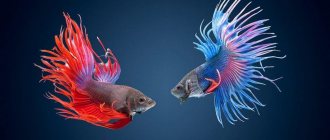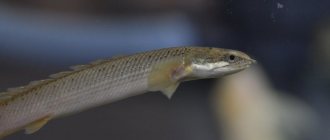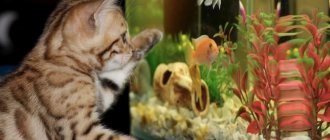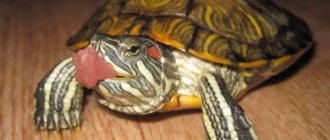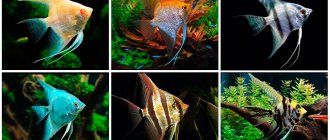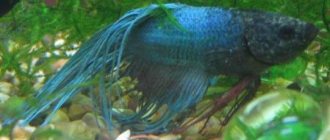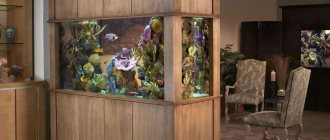Choosing an aquarium
The first step for beginners is to purchase a container for keeping fish. They may have significant differences in volume, shape and material from which they are made.
By size and volume
Experienced fish breeders know which aquarium is best to choose for beginners. It seems that a small pond is easier to care for, but this is not entirely true. In a larger volume, it is easier to form a balanced environment containing bacterial flora, which is a necessary condition for the existence of aquatic plants and aquarium fish. Experts advise buying a vessel with a volume of 60 to 110 liters.
The shapes of reservoirs are:
- round;
- square;
- rectangular;
- panoramic;
- corner;
- non-traditional (polygonal, oval, cylindrical and others).
It is preferable to opt for an aquarium of the usual rectangular or square shape - it is easier to keep it clean, it is easier to select and install equipment, and for its inhabitants this is the best and most convenient option for living.
Basic selection rules
After choosing the required shape, you should decide what material the tank should be made of. They come in two types - acrylic or glass.
Acrylic is a more suitable material for the production of aquariums.
It has its undeniable advantages in comparison with glass:
- easy;
- more durable and reliable (leakage of seams is eliminated);
- greater variety of shapes;
- lower cost.
This material also has its negative sides - its surface is easily scratched, and over time it can turn yellow or become cloudy. Therefore, it is better to purchase an aquarium made of more expensive acrylic, which will not lose its appearance over time.
Installation Requirements
When installing an aquarium at home, you must adhere to the following recommendations:
- The pond should be installed in a quiet place where there is no access to direct sunlight, and where movement and noise are kept to a minimum.
- The aquarium cabinet must be designed to support the weight of the tank along with water. It can be iron or wood, but it must be durable, with a water-repellent flat surface. The shelves are convenient for storing food and cleaning products.
- The aquarium must have easy access for changing water and cleaning.
- To connect the necessary equipment, sockets must be located in the immediate vicinity of the tank.
- The volume should correspond to the number of inhabitants on the basis that for one underwater inhabitant, 10 cm long, 10–15 liters of water are needed. This will avoid overpopulation. However, for some fish species there are different recommendations.
Daily care
The owner of the fish needs to devote 15-20 minutes of time to the inhabitants of the miniature pond every day.
The list of mandatory manipulations includes:
- Checking the tightness of the walls and the serviceability of the installed equipment. Examine the glass for cracks and drips. Make sure that the backlight is working and air is flowing into the water from the aerator. The thermometer should show the correct temperature, and the temperature difference between the water near the surface and the ground should not exceed 3 degrees.
- Inspect the tank for the presence of algae, signs of water blooms or cloudiness.
- Feeding. Daily, 1-2 times a day at a set time. Fish are prone to overeating, which can lead to their death, so monitor the activity with which they eat food.
- Inspection of freshwater inhabitants. It is produced during feeding, since at this time most of the inhabitants of the underwater world swim out of their shelters in search of food. Healthy fish are active and mobile, they do not sway or squeeze their fins. There should be no spots, rashes or sores on the body. Count your pets. If someone has died, fish out the corpse and find out the cause of death.
- Removing food residues. 20 minutes after feeding, make sure that there is no food residue left on the surface of the soil. Excess can clog the water and filter and must be removed with a siphon.
Accessories and equipment
A very important aspect is the selection and installation of equipment for the aquarium, which is necessary to ensure the life of fish and plants.
Basic equipment includes:
- lamps for additional lighting;
- compressor for saturating the aquatic environment with oxygen;
- filter;
- heater;
- thermometer.
Aquarists advise equipping the pond with a lid. This will prevent some types of fish from jumping out. Lighting lamps are often built into such covers.
Lighting
When choosing lighting devices needed for the development of vegetation, growth and reproduction of fish, fluorescent lamps are recommended. One of the main advantages of these devices is minimal heating capacity with high light output.
Among aquarists, the T5 lamp is common, the peculiarity of which is point light emission.
The use of metal halide illuminators is permitted. At the same time, MGL lamps have the same serious drawback as incandescent lamps - strong heat transfer.
An important indicator when choosing a lamp is power. It is calculated depending on the volume of the tank - at least 0.5 W per 1 liter.
Another criterion for a lighting device is its colorimetric (color) temperature, measured in Kelvin.
The larger and deeper the aquarium, the higher the color index:
- shallow containers for freshwater inhabitants - 5500-6500 K;
- reservoirs containing reefs created for marine fish and deep-sea plants - from 10,000 K;
- for the deepest aquariums - from 20,000 K.
The length of the tank should also be taken into account. If it exceeds 80 cm, then 2 lamps will be needed, over 100 cm - 4 illuminators. Accordingly, the larger the volume, the higher the power and size of the device.
Heater
Without maintaining the required temperature, it is impossible to ensure the normal functioning of the inhabitants of an artificial reservoir. Setting up an aquarium for fish requires the presence of a heating device.
Heater types:
- external, connected from the outside to the filter hydraulic hose and heating the water flow circulating through it;
- submersible, which is installed directly in the container itself;
- bottom, immersed in the aquarium soil - the best option for aquatic plants.
The best choice for a beginner would be to buy a thermostat that will automatically heat the water and constantly control its temperature, turning it on or off as needed. It is important to monitor the operation of the device - a malfunction of the heater can lead to the death of all fish and plants in the pond.
The power of the device is calculated based on 1 W per 1 liter of water.
Filter
This equipment purifies water and helps maintain the bacterial environment at the required level. Filter devices are divided into types.
The bottom filter is mounted under a layer of soil, passing through which the water flows are purified. In this case, soil oxidation does not occur, its neutral balance is maintained. Installation and maintenance of such equipment is extremely difficult, so it is rarely used at home.
The external filter is attached to the outside of the aquarium. This makes it very popular among experienced and novice aquarists. It is easily removable and convenient to clean. Experts strongly recommend washing the internal device not in tap water, but in aquarium water. This will keep the number of beneficial microorganisms contained in the filter at the required level.
The most inexpensive is an internal device that is attached to the wall of the aquarium. Using this filter also has its downsides - due to its small size, the internal filter material has to be changed quite often.
The operating principle of a canister filter is similar to an external one. The difference is that its filter plates are located in a vertical plane. It is usually installed in an aquarium cabinet or on the floor.
Filtration must be continuous, without any interruptions.
Aerator
When keeping and breeding aquarium fish at home, the list of devices necessary to maintain their normal functioning must include a compressor. It saturates the water in the aquarium with the required amount of oxygen.
When purchasing a new device, you should pay attention to the following parameters:
- power, which can be determined if the volume of the container is divided by 2;
- quiet operation, determined after connecting the aerator;
- air flow control - done manually using a valve or automatically, if provided for by the design of the device.
The compressor performs another very important function - it mixes the water, equalizing its temperature at any point. The aeration process must be continuous.
Thermometer
The thermometer allows you to monitor the condition of the water. It is very important to prevent either hypothermia or overheating of the water layers.
Most often, aquarium thermometers are equipped with suction cups, with which they are attached to the inner surface of the tank. In order for the temperature value to correspond as closely as possible to reality, the device should be attached at an average depth, at some distance from the heating apparatus. In this case, decorations or other equipment should not limit the view.
Thermometers are:
- liquid, equipped inside with a vessel partially filled with an alcohol solution;
- electronic, displaying temperature values on the display.
Each type has its pros and cons. Liquid ones are easily damaged, but are inexpensive. Electronic devices require battery replacement after a certain time and are quite expensive. The positive aspects include their high accuracy and the ability to connect a device that will automatically warn with sound signals about a sharp increase or decrease in temperature values.
Oxygen enrichment
Fish in an aquarium are living creatures that cannot live without oxygen. To ensure this, you need to install a special compressor in the tank. This device enriches the water with oxygen, supplied in the form of bubbles rising to the surface. In addition to its enormous benefits for fish, it also serves a decorative function.
Types of oxygen compressors:
- External devices – installed outside the aquarium. They are equipped with a valve to regulate the air flow. They are convenient because they do not take up extra space inside the tank. The disadvantage is that they are noisy.
- Internal compressors - installed in the aquarium. Equipped with performance adjustment that reduces energy consumption. They do not create much noise during operation. The disadvantage of the equipment is that they take up a lot of space in the aquarium, so it is better to install such models in large tanks, where there is enough space for a comfortable life for floating inhabitants.
The optimal power parameter of the device is 0.5 Watt per 1 liter of water.
Priming
Any artificial reservoir must contain soil. The thickness of its layer varies from 4 to 7 cm.
The grains of sand should be quite large, at least 1.5–2 mm in size. Sand that is too fine can cause the proliferation of parasitic microorganisms, causing cloudiness and general pollution of the aquatic environment. It is not recommended to use red or yellow sand, as it contains iron, which reacts chemically with water.
The soil may also contain small granite pebbles, ranging from 3 to 8 mm in length. Longer stones should not be placed on the bottom, since organic matter will not linger between them and will be easily washed out. Aquarium soil serves as a natural filter and habitat for beneficial bacteria.
The soil should not contain limestone deposits, which can cause an increase in water hardness. The basalt covering the bottom will help reduce it. It is advisable that the stones do not contain sharp ribbed surfaces that could injure underwater inhabitants.
One of the common mistakes of novice aquarists is to use river sand as bottom soil, which contains a large number of hostile microorganisms and crustaceans that infect fish and plants and cause their death.
Siphon
A siphon is a simple hose with a nozzle designed to drain water from an aquarium and clean the soil from fish waste. I recommend purchasing a siphon with a bulb, because this will save you from having to “drain gasoline” every time you use it: just press the bulb a couple of times and the water will flow by gravity into the bucket.
Scenery
Many people strive to decorate the aquarium with various decorative elements - artificial grottoes, driftwood, beautiful shells, stones, corals, underwater castles, stylized as sunken pirate ships. Decorations can also have the additional function of protecting fry from adults.
Choosing an Ecosystem Type
Which fish to get for a novice aquarist depends on the choice of marine or freshwater habitat.
Freshwater aquarium
Common types of freshwater fish:
- Neons;
- Guppy;
- Discus;
- Barbs;
- Haplochromis;
- Cichlids.
For beginners, a better alternative is the freshwater ecosystem, which is much easier to maintain. The inhabitants of freshwater aquariums are less demanding than marine fish and plants.
Seawater aquarium
A tank with a marine environment is more suitable for experienced breeders, as it requires more careful control over the chemical parameters of the water composition - acidity, hardness, salinity, and temperature. Maintenance of a sea reservoir also requires the installation of additional expensive equipment.
Types of aquarium fish that live in salt water:
- Angelfish;
- Blenny;
- Clowns;
- Surgeon fish;
- Bodies;
- Pseudochromis;
- Fox fish;
- Mandarin ducks.
Soda
It is strictly forbidden to wash the aquarium and its equipment with soap or dishwashing detergents. For these purposes, you need to use ordinary baking soda, which you can purchase at almost any grocery store. After cleaning the aquarium with soda, it must be thoroughly rinsed with running water.
Plant selection
Aquariums for beginners allow the use of artificial plants that will require minimal care. It is enough to clean them occasionally. Living plants require more care, but bring undeniable benefits - underwater inhabitants can lay eggs in them and hide from other fish. Plants provide an additional source of oxygen, and some of them can serve as food for fish.
Popular varieties of aquarium vegetation:
- Vallisneria;
- bacopa;
- ludwigia repens;
- Java moss;
- rotalla;
- Anubias dwarf;
- Echinodorus Amazonis;
- elodea;
- peristolistic;
- hornwort;
- Thai fern.
Plants grown in a natural reservoir cannot be transplanted into aquarium soil.
Lamp
An aquarium light is essential for plant growth and also for creating a natural habitat for fish by simulating sunlight. The power of the lamp should be selected based on the volume of the aquarium. Light that is too low may not be sufficient for certain types of plants, while light that is too bright may lead to algae growth.
Selection of fish
Beginners are recommended to choose varieties that do not require special conditions.
Unpretentious fish for beginner aquarists
You can start breeding fish with the following varieties:
- swordtails;
- guppy;
- catfish;
- platies;
- lalius;
- barbs;
- cardinals;
- goldfish;
- mollies.
The above species easily tolerate temperature fluctuations and minor changes in the chemical composition of water. Catfish are natural cleaners - they absorb leftover food and organic matter covering the bottom, and some varieties are able to clean plaque from aquarium walls.
Due to their unusual appearance and unpretentiousness in maintenance, goldfish are very popular. They were bred artificially and belong to the genus of crucian carp. They can be bred in small ponds or aquariums. This species has about 300 varieties, differing significantly in body structure and color. Goldfish can be classified as long-livers - there are known facts when some individuals lived up to 40 years.
How to launch fish
Before populating a reservoir with new inhabitants, you should check whether they can coexist peacefully with each other.
You cannot introduce a large number of different species of fish at once. This should be done gradually, without rushing.
What to look for when purchasing and delivering an aquarium home
When you choose or accept an aquarium, you need to pay attention to a number of factors. You should be provided with a warranty card, and if you made it to order, then also an acceptance certificate for the goods. These are standard documents that need to be checked for any major purchase. Never sign anything before you have thoroughly inspected the aquarium.
Aquarium glass
First of all, we inspect the glass for cracks, scratches, chips, and voids. Even the slightest damage to the aquarium glass can be fatal upon startup. Microscopic scratches can become unpleasant and irritating when the aquarium is running and the lights are on. Moreover, a crack that can grow very quickly and cause a flood and death of the inhabitants.
Aquarium seams
Seams are one of the main indicators of the quality of an aquarium. They should be smooth, not bulge anywhere or form gaps. If you find traces of sealant on the glass, then this is a low quality product and you definitely don’t need to purchase it.
End part of glass
The cut areas of the glass must be sanded. If the aquarium was made at home by an amateur, then the edges will simply be cut off. Firstly, ground glass is much safer. Secondly, grinding removes microcracks, which can cause a large aquarium to split.
Feed selection
Each species of underwater inhabitants has its own food preferences. Food intended for fish living in the upper and middle layers should not sink to the bottom. Food can be dry, live or frozen. Experienced breeders advise alternating them - this will allow the fish to receive all the nutrients necessary for normal life.
Basic feeding rules
For small and medium-sized fish, food consisting of large flakes or granules should be crushed.
Experts advise following a time schedule and feeding at the same time. It is prohibited to overfeed aquarium inhabitants - they are given food no more than once a day. Every 7-10 days, in order to prevent obesity, skip one feeding.
It is important to choose the amount of food so that it is completely eaten in 5-7 minutes. The remaining particles settling to the bottom can cause turbidity and cause uncontrolled proliferation of dangerous microorganisms.
Cabinet
If you have decided on the aquarium, let's move on to the next important stage - choosing a cabinet for it. Of course, the tank can be placed on any other flat, stable surface, but still the cabinet is a convenient and useful thing. For example, you can store things for caring for your aquarium in it.
When deciding to buy a cabinet, consider the main points:
- it must be moisture resistant;
- durable, easily supporting the weight of a filled tank;
- It is desirable that it be on adjustable legs.
To avoid deformation of the cabinet under the weight of the aquarium, some opt for a metal product.
But such a cabinet will cost more. Did you know? Researchers from the USA have found that people who have an aquarium at home are more successful in their careers, creativity and personal relationships. Perhaps this is due to the fact that the owners of artificial reservoirs watch the fish every day before going to bed and always wake up cheerful and in a good mood.
Small inventory
Various tools are commercially available for maintaining an aquarium. They must be made of safe materials that do not react with the aquatic environment.
Net
There must be at least two of them. The minimum recommended net size is 10 by 15 cm. Fishing should be done without making sudden movements, using two nets at the same time. This will help avoid severe stress in the fish. To make nets, use a mesh made of nylon or compacted fabric, if it is necessary to catch fish with spikes.
Glass scraper
This tool is necessary in order to clean the walls of the tank from algae and plaque formed on them. Scrapers can be magnetic or metal. When using metal wipers, precautions must be taken to ensure that the acrylic or glued seams in the glass aquarium are not damaged.
Bottom cleaning siphon
Using a siphon, the soil is cleaned, removing organic residues and silt. You should not carry out this procedure too often, so as not to upset the balance and destroy the formed beneficial bacterial flora.
Feeders
This equipment helps to avoid water pollution. Using a feeder prevents food from spreading throughout the pond.
Special household chemicals
To clean glass surfaces, any detergent can be used. It should be remembered that the container must be rinsed very thoroughly, otherwise the chemical residues will disrupt the eco-balance of the reservoir, cause poisoning of fish and plants, and cause their death.
Acrylic tanks are more expensive to maintain, as they need to be cleaned with special preparations to prevent clouding of the surface.
Network filter
As you already understand, all aquarium equipment requires a constant supply of electricity. A filter, compressor, lamp and thermostat must be connected to the network. Thus, you will need 4 sockets at once. Using “tees” is not very safe, so I advise you to purchase a good surge protector with a sufficiently large number of outlets so that you can connect additional equipment if necessary. Ideally, if the surge protector has at least 5 sockets, then you will always have at least one in stock.
Starting an aquarium
All equipment has been purchased and installed, all that remains is to start the aquarium. Before placing the fish in a glass tank, it is filled with water for several days. This will allow you to test the seams for strength. Then the water must be completely drained, since in some cases the new joint putty may enter into a chemical reaction with the environment.
The second step is the placement of soil and decorative elements, installation of basic equipment, and planting of vegetation.
The aquarium is then filled with water. It is advisable that it sit for a couple of days before doing this, otherwise, due to the presence of chlorine in the composition, the plants will begin to get sick and it will be more difficult for them to adapt.
After planting the vegetation, connect the filter device, compressor, and heater.
To ensure that parameters such as acidity and hardness are as close as possible to values comfortable for fish, special agents are added to the aquatic environment. It is better to carry out this procedure after consultation with a specialist. The level of acidity and hardness is determined using special tests.
6-7 days after the equipment is launched, ampularia snails are added to the reservoir, with the help of which the eco-balance necessary for the life of the fish is formed.
After populating the ampullaria, they begin to gradually add fish. First, unpretentious pets are introduced, and the aquarium is completed with the most capricious and demanding inhabitants.
When transplanting fish into a tank, you must first immerse it in water along with the bag and wait until the temperature equalizes, and only then release it.
Vegetation
Three days after filling the aquarium with water, you need to start planting vegetation. For beginners, unpretentious varieties of flora such as ferns, mosses, different types of cryptocorynes and echinodorus are suitable. Aquarium flora is divided into several varieties, each of which is planted in a specific place: for example, flowers with a long and strong stem are planted in the background of the tank, and small and low shrubs are planted in the front.
Setting up an aquarium that is about to be launched for the first time should include planting many plants, since a small number of flowers will not cope with harmful algae and bacteria. Having placed the selected types of flora, you should turn on lighting fixtures for the growth and development of vegetation.
Aquarium Maintenance
Instructions on how to keep an aquarium at home include a description of all the manipulations necessary to ensure that its inhabitants are healthy, beautiful and delight their owner.
Soil cleaning
Most often, this procedure is combined with changing the water. Before this, the decorative elements are removed and washed. All devices are turned off while the siphon is being used. It is recommended to clean every 30-45 days, depending on the size of the aquarium.
Glass cleaning
It is best to clean glass from plaque and algae using a magnetic scraper. From available means, you can use an unnecessary plastic card. Cleaning is done every 7-10 days.
Cleaning and replacing the filter
The material through which the water flow circulates should be replaced every 5-6 months. Experts strongly recommend washing the internal structure of the filter not in tap water, but in aquarium water. This will keep the number of beneficial microorganisms contained in the filter at the required level.
Water change
The water is partially changed every 7-10 days, depending on the size of the container. 25-30% of the total volume is drained, instead of which clean, settled water is added.
Sterilization
If there are parasitic bacteria or protozoa in the water, a sterilization procedure should be carried out. It comes in two types: ozone and ultraviolet. The ozone method is suitable for experienced aquarists, and the ultraviolet method, due to its accessibility, is suitable for beginners.
Cover glass
You can purchase a cover glass for your aquarium. Very often it comes either complete with an aquarium, or its role is played by a plastic cover with a built-in lamp and a small hole for feeding fish. Despite the fact that the second option looks more pleasant, the lamp included in the kit is often quite weak. Replacing it with a more powerful one is usually not possible. Therefore, the built-in lamp will not allow you to grow those plants that require a lot of light. That is, perhaps over time the aquarium lid will be removed to the loggia or mezzanine.
The cover glass allows light to pass through and allows you to install any light fixture you like. The most difficult thing here is to choose the size and shape of the glass so that it does not interfere with the mounting of aquarium equipment, including the lamp.
A cover glass reduces the rate of water evaporation, covers the aquarium from dust, and also prevents some aquarium inhabitants from escaping.
Rules for aquarists
Recommendations from experienced aquarists help beginners monitor the condition of the reservoir.
Basic Rules:
- It is necessary to observe what the fish look like. They should have a healthy appearance and bright colors.
- Before purchasing a new species, you need to make sure that it is compatible with other inhabitants of the aquarium.
- Do not knock on the walls of the tank to scare the fish.
- Dead fish should be removed without delay.
- Sick individuals must be transplanted into an isolated container.
Basic mistakes
Errors in care can lead to the death of fish and plants.
The main errors include:
- untimely cleaning can cause cloudy water and the growth of parasitic bacteria;
- incompatibility of inhabitants;
- overpopulation of the reservoir;
- the first introduction of fish into unsettled tap water;
- violation of the conditions of maintenance of certain species;
- overfeeding fish;
- planting plants, snails caught in natural bodies of water;
- not sterilized decorative elements (pond stones, driftwood);
- lack of cover;
- inconvenient shape of the vessel;
- non-compliance with temperature conditions;
- periodic shutdown of the compressor and filter;
- lighting lamps should operate for no more than 12 hours, simulating daylight hours.
Water
Prepare the water before starting. It settles for at least a day; it should not contain chlorine or other harmful impurities. You will need special water tests and a bacterial culture for the first run. Some types of fish need soft or, conversely, hard water. The liquid is softened by boiling or freezing. Water becomes harder due to stones and shells.

